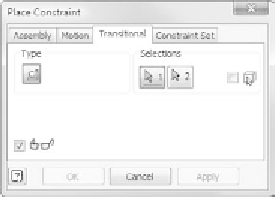Graphics Programs Reference
In-Depth Information
an interference condition by using a negative value. In an Angle constraint, this
prompt changes to enter the angle value.
The Motion Tab
The Motion tab contains two types of constraint for creating relationships that
can be activated to re-create how parts move in a mechanism: Rotation and
Rotation-Translation.
A Rotation constraint can replicate gearing or rollers using the Reverse solu-
tion. You can also apply a ratio to the relationship between the two bodies to
allow them to turn at different rates. The Forward solution turns the bodies in
the same direction with the option of defi ning a ratio.
The Rotation-Translation type can emulate a rack-and-pinion joint or the
movement of a slide being driven on a threaded shaft by creating a relationship
between the rotation of a face and the movement of a body. The Distance value
governs how far the second part moves during one revolution of the fi rst part.
To emulate a rack and pinion, you set this value to the circumference of the pin-
ion. The Forward and Reverse solutions allow you to select the direction of the
linear movement in relation to the rotation.
The Transitional Tab
The Transitional tab has only one tool. It applies a Tangency constraint that can
follow a curved face such as a cam. The mating faces remain tangent as long as
there is a tangency to follow.

































Search WWH ::

Custom Search